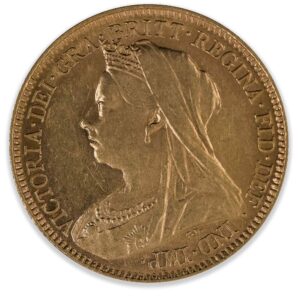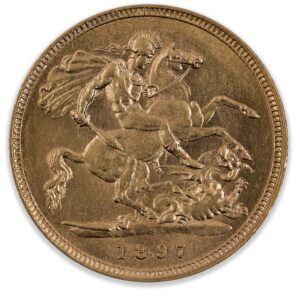The Veiled Head Half Sovereign, often referred to as the “Old Head” design, represents the final portrait of Queen Victoria to appear on British coinage. Introduced in 1893 and continuing until her death in 1901, these coins offer collectors and investors a tangible connection to the twilight years of the Victorian era.
The Veiled Head design was created by Sir Thomas Brock RA and shows Queen Victoria in a more solemn and dignified manner than the preceding Jubilee Head:
- Queen Victoria is portrayed facing left, wearing her crown and veil
- She is depicted with the Order of the Garter ribbon and the Victoria and Albert order
- The portrait shows Victoria as an elderly monarch, acknowledging her advancing years
The veil symbolises her continued mourning for Prince Albert, who had died in 1861
This portrait captured Victoria’s enduring grief – despite Albert’s death having occurred more than 30 years earlier, Victoria continued to wear traditional black mourning clothes for the remainder of her life.
The Reverse Design
Unlike the Jubilee Head half sovereign, which featured a shield design, the Veiled Head half sovereign introduced a significant change to the reverse:
- The design depicts St. George slaying the dragon, created by Benedetto Pistrucci
- This marked the first time this iconic design appeared on half sovereigns during Victoria’s reign
- Previous Victoria half sovereigns had featured shield designs
This change unified the design elements of sovereigns and half sovereigns, as both denominations now featured the St. George and dragon motif.
The Veiled Head half sovereign represents not just a gold investment vehicle but a historical artifact from the twilight of Queen Victoria’s remarkable 63-year reign. For collectors focusing on Australian gold coins, the Sydney and Melbourne mint issues offer particular interest as commonwealth-produced examples of this important final Victorian design.
FAQs
The design is officially known as the “Veiled Head” due to the mourning veil Queen Victoria wears in the portrait. However, collectors often refer to it as the “Old Head” design because it depicts Victoria in her elderly years, contrasting with the “Young Head” design used earlier in her reign. Both terms are considered correct in numismatic circles.
The change to St. George and the dragon for half sovereigns represented a significant departure from tradition. Previously, only full sovereigns featured this iconic design, while half sovereigns used various shield designs. The switch unified the sovereign and half sovereign designs and coincided with a broader modernisation of British coinage. The St. George design was considered more artistic and had been highly praised since its introduction on sovereigns in 1817.
Yes, Queen Victoria personally approved the design created by Sir Thomas Brock. Historical records indicate she was pleased with this more dignified representation of her later years, in contrast to the somewhat controversial Jubilee Head design that preceded it.
Veiled Head Half Sovereigns were produced at multiple mints within the British Empire:
- London (no mint mark)
- Sydney (S mint mark below St. George on reverse)
- Melbourne (M mint mark below St. George on reverse)
- Perth (P mint mark below St. George on reverse, rare)
The Veiled Head design represents one of the key types in a complete Victorian gold collection:
- Young Head (Shield Reverse): 1838-1887
- Jubilee Head (Shield Reverse): 1887-1893
- Veiled Head (St. George Reverse): 1893-1901
When combined with Edward VII, George V, and modern issues, they form part of the complete sovereign and half sovereign lineage.

